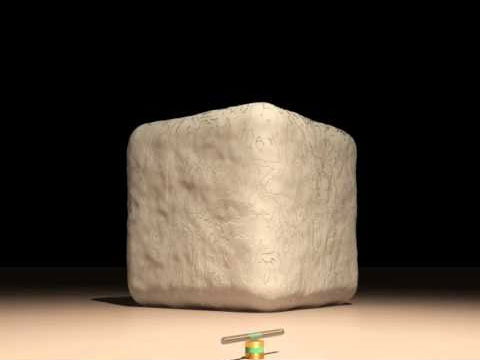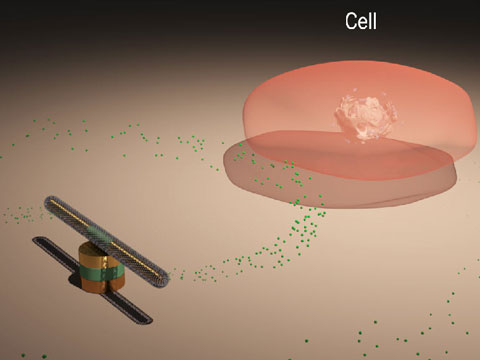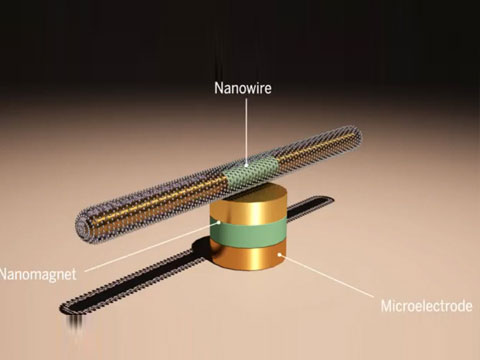
محققان موفق به ساخت کوچکترین ، سريعترين و بادوامترین نانوموتور جهان شدند که قادر به رهاسازی کنترل شده دارو بوده و سرعت چرخش این نانوموتور قابل مقایسه با چرخش موتور هواپیما است. در ادامه در گجت نيوز شاهد توضيحات تکميلي باشيد .
پژوهشگران مدرسه مهندسی کاکرل در دانشگاه تگزاس با ساخت این نانوموتور گام بسیار مهمی به سوی توسعه ماشینهای کوچک برداشتند که در آینده میتواند برخی فعالیتهای بدن نظیر رهاسازی انسولین یا داروهای شیمیدرمانی را انجام دهد.

در تصویر بالا مقایسه مدل شبیه سازی شده موتور الکترونیکی را با دانه نمک مقایسه می کنید
برای رسیدن به این هدف، محققان این پروژه درصدد تولید ابزاری برآمدند که بتواند انرژی الکتریکی را به حرکت مکانیکی تبدیل کند، آن هم در مقیاسی 500 مرتبه کوچکتر از دانه نمک.

دانگل فان از محققان این پروژه موفق به طراحی، ساخت و تست این نانوموتور زیستی شد. این موتور سه بخشی، میتواند با پمپهای خود مواد بیوشیمیایی را ترکیب کرده و از میان یک سیال عبور دهد که این ویژگی میتواند کاربردهای متعددی در آینده داشته باشد.
این نانوموتور که ابعاد کمتر از یک میکرون دارد، میتواند درون سلولهای انسان قرار گرفته و با سرعت18 هزار دور در دقیقه به مدت 15 ساعت، بدون توقف، بچرخد. سرعت حرکت این نانوموتور، با موتورهای هواپیما برابری میکند. نانوموتورها میتوانند در توسعه سیستمهای نانوالکترومکانیکی بسیار موثر باشند. این گروه تحقیقاتی معتقدند که به زودی از این نانوموتور جدید برای رهاسازی هوشمند دارویی به درون سلولها استفاده کنند.

برای تست توانمندی رهاسازی دارویی، این گروه تحقیقاتی سطح نانوموتور را با مواد بیوشیمیایی پوشش داده و آنها را به حرکت در آوردند. نتایج نشان داد که با افزایش سرعت حرکت نانوموتور، رهاسازی دارویی تسریع میشود.
فان میگوید: ما میتوانیم با تنظیم حرکت موتور، مقدار مولکول رهاسازی شده را کنترل کنیم. در واقع میتوان گفت که این اولین نانوموتوری است که میتوان دارو را از سطح نانوذرات رهاسازی کرد. ما معتقدیم که این نانوموتور میتواند برای مطالعه رهاسازی دارویی و ارتباط میان سلولی استفاده شود.
محققان برای ساخت این نانوموتور از روشی ثبت اختراع شده استفاده کردند، روشی که مبتنی بر میدانهای الکتریکی متناوب و مستقیم است.
فان و همکارانش قصد دارند تا روشهای کنترلی جدیدی روی این نانوموتور پیاده کنند و همچنین حسگری شیمیایی آن را توسعه دهند تا در نهایت بتوانند از این نانوموتور در ادوات نانوالکتروشیمیایی استفاده کنند. اولین برنامه، تست نانوموتور در سلول زنده است.
منبع : mashable
World's Smallest Nanomotor Spins as Fast as a Jet Engine
Researchers in Texas have created the nano-version of the Energizer Bunny. Their new nanomotor rotates at 18,000 RPMs for a whopping 15 hours. Previous nanomotors rotated far more slowly and sputtered out after a few minutes. The tiny technology, also known as "Ultrahigh-Speed Rotating Nanoelectromechanical System (NEMS)" is a potential breakthrough for treating all kinds of human ailments including, you guessed it, cancer. Built by a team at Cockrell School of Engineering at The University of Texas at Austin and led by Dr. Donglei (Emma) Fan, the motor is actually a collection of nano-entities, including a nanowire and patterned nano magnets. In their research paper, the engineers recount all the less successful previous nano-work the new nanomotor is built upon, including experiments from Cornell University where out of hundreds of synthesized nanomotors, only a few rotated and at UC Berkeley, which built an excellent nanomotor using electron-beam lithography that, unfortunately, required an overly complex fabrication procedure. Cockrell's nanomotor, however, is built more simply and effectively in part because of another Cockrell invention, Electric Tweezers, a nano-manipulation technique that allowed the team to not only transport the nano-entities, but precisely position them within 150 nanometers and then rotate them exactly how they wanted. Not only can these nanomotors rotate like nobody's nano-business (almost as fast as a Lear jet engine), a group of them can do it in sync.At 500 times smaller than a grain of salt, these nanomotors could one day work inside cells and spin together to deliver cancer-killing medicines. The future, however, is even crazier. Researchers envision building entire nano robots out of a group of these nanomotors, which can then work together to diagnose, grab and treat cells. The nanomotor joins an ever-growing list of nano-breakthroughs. Earlier this year, researchers in Denmark built a drug-delivery cage out of DNA. Maybe one day the nanomotors will go to work while carrying these nanocages. Have something to add to this story? Share it in the comments.
 گجت نیوز آخرین اخبار تکنولوژی، علم و خودرو
گجت نیوز آخرین اخبار تکنولوژی، علم و خودرو 





